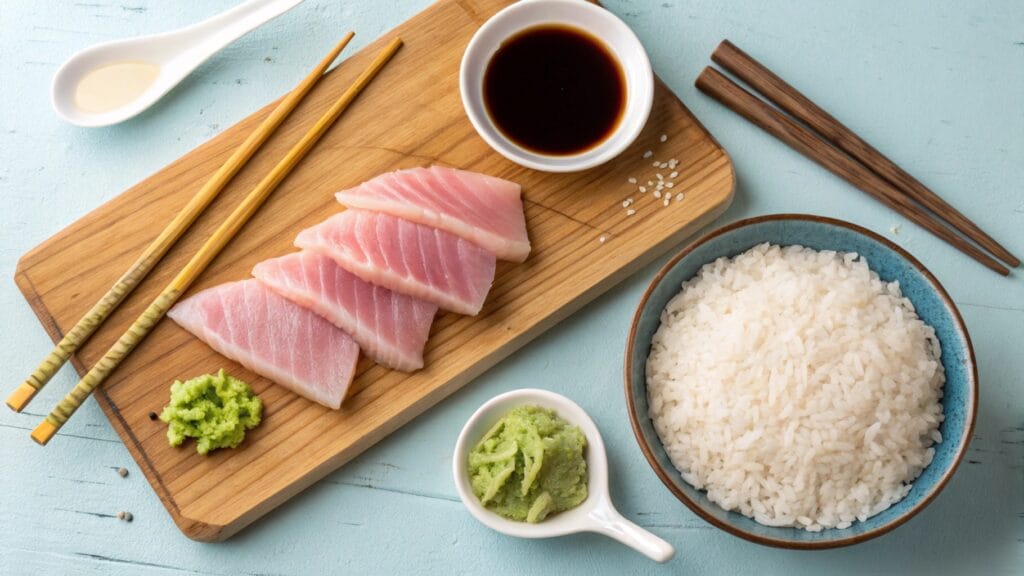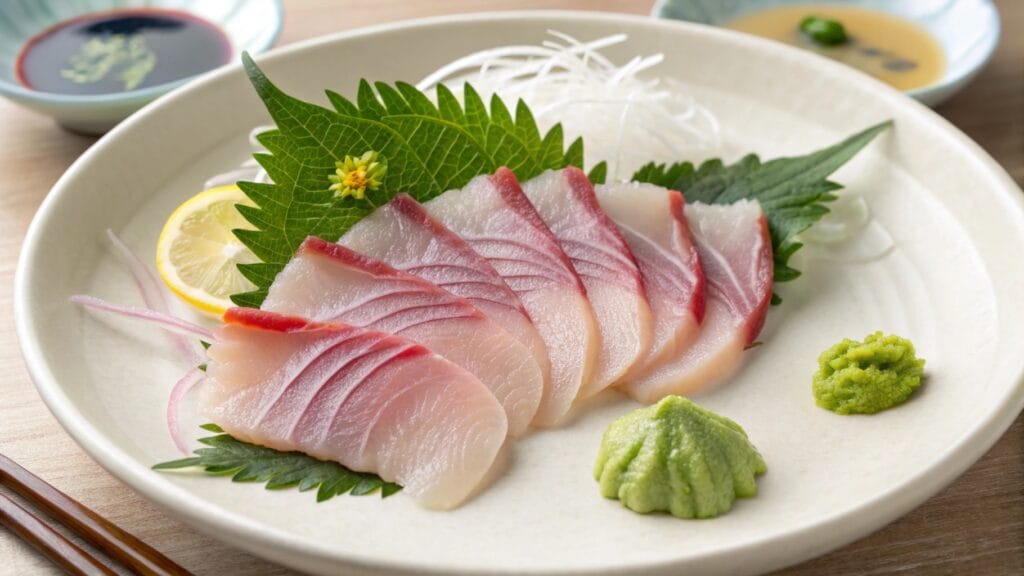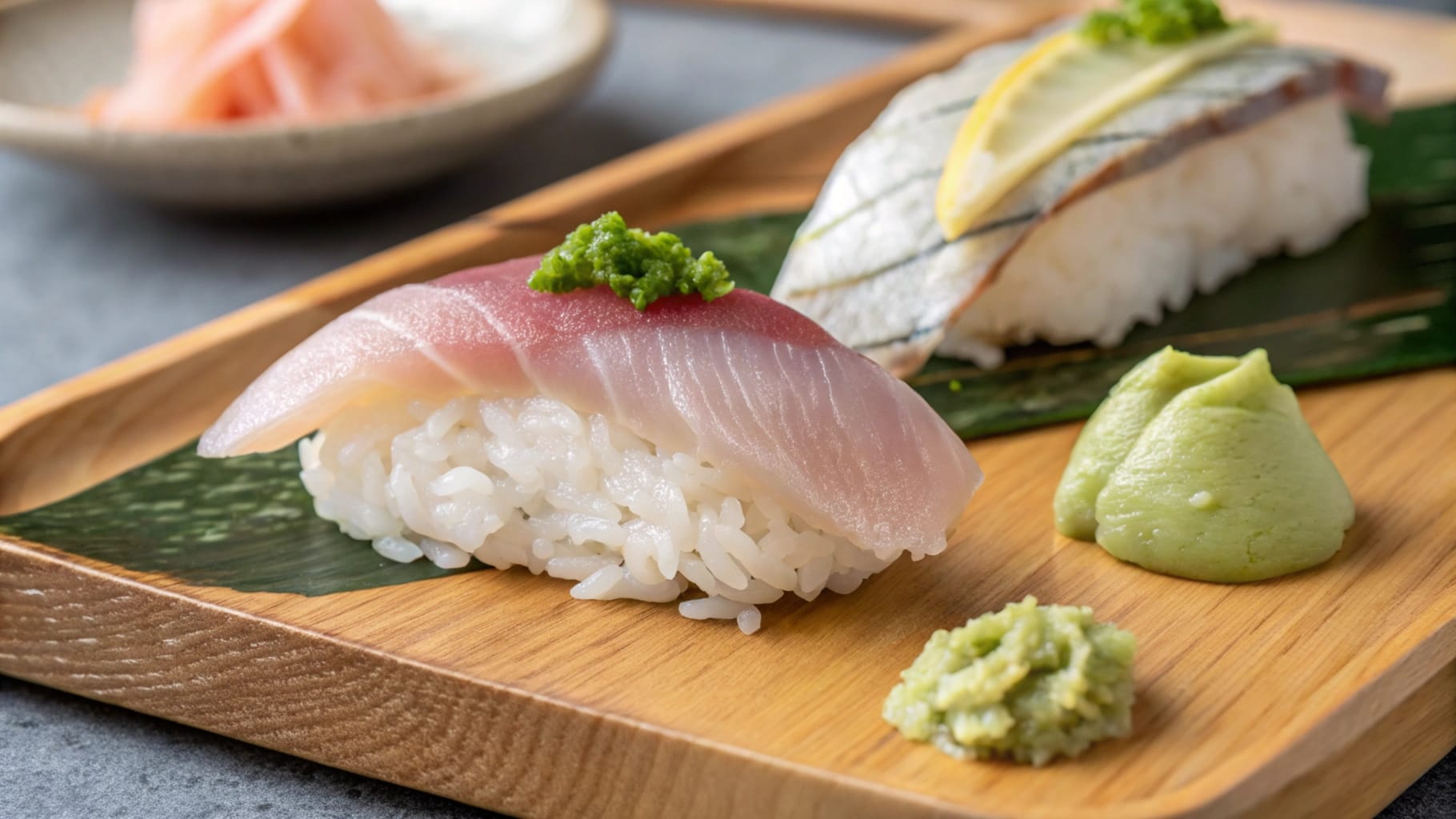Are you a fan of sushi or looking to explore new, delicious seafood options? If so, you’ve probably heard of Hamachi fish. But what exactly is Hamachi, and why is it so popular? In this ultimate guide, we’ll dive deep into everything you need to know about Hamachi, from its nutritional benefits to how to cook it like a pro.
Let’s explore the fascinating world of this prized fish—whether you’re a seasoned seafood lover or a newbie, you’ll find something to love!
What is Hamachi Fish?
Overview of Hamachi Fish (Yellowtail)
Hamachi, also known as Yellowtail, is a type of fish found in the Pacific Ocean, particularly around Japan. This delicious fish is prized for its rich, buttery flavor and its smooth, firm texture.
But here’s the catch (pun intended)—Hamachi is a broad term that actually refers to a few different types of fish, all of which belong to the same family. While Hamachi is commonly used in Japan, it’s also known as “yellowtail” in other parts of the world. When you hear someone say “Hamachi,” they’re usually referring to the young fish of the species Seriola quinqueradiata.
These young fish are raised in special farms to ensure they’re at their peak flavor and texture, making them perfect for sashimi, sushi, or just grilling. The fish is known for its bright, golden skin and white, tender flesh.
Differences Between Hamachi, Buri, and Yellowtail
You might be wondering: isn’t Hamachi just Yellowtail? The answer is a bit more complicated. While Hamachi and Yellowtail are often used interchangeably, there’s a subtle difference. Here’s a breakdown:
- Hamachi: This is the young version of Yellowtail, typically under 5 years old. It’s the most sought-after for sushi and sashimi due to its tender texture and clean taste.
- Buri: As Hamachi grows older, it becomes Buri. Buri is often larger and has a richer, stronger flavor. It’s commonly used in Japanese cuisine for grilling and simmering.
- Yellowtail: This term is used globally to describe several species in the Seriola family, including both Hamachi and Buri. In the U.S., Yellowtail is often used to describe the species that are caught in the wild, which tend to be more robust in flavor.
So, when you order Hamachi at a sushi restaurant, you’re likely getting the younger, more delicate fish—perfect for those who prefer a mild yet flavorful bite.
Nutritional Benefits of Hamachi Fish
Eating Hamachi isn’t just a treat for your taste buds—it’s also great for your health! This fish is packed with nutrients that can help improve your overall well-being. Here are some of the top benefits of Hamachi:
Protein Content and Its Health Benefits
Hamachi is a fantastic source of lean protein, which is essential for muscle growth and repair. Protein also plays a crucial role in supporting a healthy immune system and keeping your skin, hair, and nails strong. Just a small serving of Hamachi can give you a solid protein boost to fuel your day.
For those who are into fitness or looking to maintain a balanced diet, Hamachi provides a clean source of protein without excess fat. Whether you’re working out or just trying to stay healthy, adding fish like Hamachi to your meals is a smart choice.
Omega-3 Fatty Acids: Why They Matter
One of the standout benefits of Hamachi is its high content of Omega-3 fatty acids. These healthy fats are crucial for brain health, heart health, and even reducing inflammation in your body. If you’re not getting enough Omega-3s in your diet, Hamachi is a tasty way to add them in.
In fact, research has shown that Omega-3s can help reduce the risk of heart disease, lower blood pressure, and improve cholesterol levels. These fatty acids are also linked to improved memory and brain function. So, if you’re looking to improve your brain power or take care of your heart, Hamachi can help!
Essential Vitamins and Minerals in Hamachi
Hamachi is also a great source of several essential vitamins and minerals that your body needs to function at its best:
- Vitamin D: Helps with calcium absorption and promotes healthy bones.
- Vitamin B12: Crucial for nerve function and the production of red blood cells.
- Selenium: A powerful antioxidant that supports a healthy immune system.
- Potassium: Helps maintain healthy blood pressure levels.
These nutrients can play a key role in keeping your body strong and healthy, making Hamachi not only delicious but nutritious too!
How to Prepare and Cook Hamachi Fish
Now that you know how nutritious Hamachi is, let’s talk about how to prepare and cook it! Whether you’re a beginner or a pro, Hamachi is versatile enough to be prepared in a variety of ways. Let’s take a look at the most popular methods.
Common Cooking Methods: Grilling, Searing, and Sashimi
Grilling Hamachi
Grilling Hamachi is one of the easiest and most flavorful ways to prepare it. When grilled, Hamachi gets a crispy, golden-brown exterior while maintaining its juicy, tender inside. To grill Hamachi, just season it with a little salt, pepper, and olive oil, and place it on a preheated grill. Grill each side for about 3–4 minutes until it’s nicely charred and cooked through.
Searing Hamachi
Searing is another great method, especially if you’re looking for a slightly crispy texture on the outside while keeping the fish raw on the inside. This is perfect for dishes like Hamachi crudo, which is a raw fish dish that’s seasoned with citrus, herbs, and a dash of olive oil. To sear, heat a pan with a bit of oil, and cook the Hamachi for just a couple of minutes on each side until it’s golden brown but still tender and raw in the middle.
Hamachi Sashimi
Of course, Hamachi is most famous for sashimi. This dish features thinly sliced pieces of raw fish, served with a soy-based dipping sauce, wasabi, and pickled ginger. To make Hamachi sashimi, it’s important to start with the freshest fish possible. It’s best to have a fishmonger or sushi chef cut the fish, but if you want to do it yourself, just be sure to use a sharp knife to slice thin, clean pieces.
Delicious Hamachi Recipes to Try at Home
If you’re looking to make your own Hamachi dishes, here are a couple of ideas to get you started:
- Hamachi Nigiri: Thinly slice the fish and place it atop small mounds of seasoned rice. Serve with a dab of wasabi for an authentic sushi experience.
- Hamachi Tacos: Cube the fish and toss it with some lime juice, cilantro, and a dash of hot sauce. Spoon it into small soft tortillas for a unique twist on tacos.
- Hamachi Poke Bowl: Mix cubed Hamachi with soy sauce, sesame oil, avocado, and cucumber. Serve over rice for a fresh, flavorful poke bowl.
Common Mistakes When Cooking Hamachi and How to Avoid Them
While Hamachi is a versatile and easy-to-cook fish, there are a few common mistakes to watch out for:
- Overcooking: Hamachi is best enjoyed when it’s tender and juicy. If you overcook it, it can dry out and lose its delicate flavor. Stick to cooking methods that maintain moisture, like grilling over medium heat or searing quickly.
- Not Letting it Rest: If you’re cooking Hamachi, be sure to let it rest for a minute or two before serving. This helps retain the fish’s juices and ensures a flavorful bite.
- Using Old Fish: The key to great Hamachi dishes is using fresh fish. If you’re buying from a store, check the color of the flesh (it should be a translucent pink) and make sure it doesn’t smell overly fishy.

Table: Hamachi Fish Nutrition Facts
| Nutrient | Amount (per 100g) |
|---|---|
| Calories | 200 kcal |
| Protein | 23g |
| Total Fat | 12g |
| Omega-3 Fatty Acids | 2.5g |
| Vitamin B12 | 2.5mcg |
| Vitamin D | 3.5mcg |
| Potassium | 300mg |
| Selenium | 25mcg |
Where to Buy Hamachi Fish: Sourcing and Selection Tips
If you’re excited to try cooking Hamachi at home, the next step is to figure out where to buy it. While you can find Hamachi at some local grocery stores, it’s best to go to specialty markets or fishmongers for the freshest catch. Let’s dive into some tips for sourcing and selecting the best Hamachi for your dishes!
Best Sources for Fresh Hamachi
When looking for fresh Hamachi, the best place to start is often a high-quality seafood market. These markets tend to carry the freshest fish available, especially if you’re after premium-grade Hamachi for sushi or sashimi.
Another great option is local Japanese grocery stores. These stores often carry a selection of imported fish, including fresh Hamachi. If you don’t have access to a local market, consider online seafood vendors that specialize in shipping fresh fish directly to your door.
If you’re near a coastal area or a port, a local fishmonger could be a treasure trove for fresh seafood. Just ask for Hamachi and they’ll usually know exactly what you’re looking for.
How to Identify High-Quality Hamachi Fish
When selecting Hamachi, look for these signs to ensure you’re getting the best quality:
- Color: Fresh Hamachi should have a bright, shiny, and slightly translucent appearance. The flesh should be a pale pinkish-white, with a hint of gold around the skin.
- Smell: Fresh Hamachi shouldn’t have a strong “fishy” smell. It should have a clean, ocean-like aroma. If it smells overly pungent, it’s best to pass on it.
- Firmness: Gently press on the flesh of the fish. It should feel firm and bounce back, not mushy. Fresh Hamachi will hold its shape and texture.
- Eyes: If buying whole fish, the eyes should be clear and not cloudy. Cloudy eyes are a sign that the fish is past its prime.
Frozen vs. Fresh Hamachi: What You Need to Know
If fresh Hamachi is unavailable, don’t worry—frozen Hamachi can still offer a great eating experience! In fact, many sushi restaurants use frozen fish for sashimi due to the fact that freezing helps kill parasites, making it safer to eat raw.
When buying frozen Hamachi, look for fish that has been flash-frozen to preserve its texture and flavor. Flash-freezing helps lock in the freshness and prevents freezer burn. If you’re buying frozen Hamachi, make sure to let it defrost in the fridge overnight before using it to maintain its best texture.
Common Problems with Hamachi Fish and How to Solve Them
While Hamachi is a relatively easy fish to work with, there are a few challenges that might come up. Let’s go through some of the most common problems you may encounter when handling or cooking Hamachi, and the best solutions to solve them!
Issues with Freshness and How to Store Hamachi Properly
One of the biggest problems with buying Hamachi is ensuring that it stays fresh. Like most fish, Hamachi is highly perishable. Here’s how to keep it fresh:
- Refrigeration: If you’re not using the fish immediately, store it in the coldest part of your fridge (usually at the back) in an airtight container. Ideally, you want to use the fish within 24 hours.
- Freezing: If you need to keep it longer, freezing is your best option. Wrap the Hamachi tightly in plastic wrap and aluminum foil before placing it in the freezer. Just remember, the fresher the fish before freezing, the better the texture and flavor after thawing.
How to Handle and Defrost Hamachi Fish Safely
If you’re using frozen Hamachi, proper thawing is key to keeping the fish at its best:
- Slow Thawing: For the best results, place the frozen fish in the fridge and let it thaw slowly overnight. This method helps the fish retain its texture and prevents it from becoming too mushy.
- Quick Thawing: In a pinch, you can place the fish in a sealed plastic bag and submerge it in cold water for about an hour. Avoid using hot water, as it can cook the fish and ruin its delicate texture.
Overcooked Hamachi: How to Prevent and Fix It
Overcooking Hamachi is a common mistake that can lead to a dry, tough texture. Hamachi is best when it’s cooked quickly and remains moist inside. If you’re grilling or searing, be sure not to leave it on the heat for too long.
For grilled Hamachi, aim for 3–4 minutes per side on medium heat. If you’re searing, cook it for just 1–2 minutes on each side. The key is to remove the fish from the heat while it’s still tender and juicy.
If you’ve accidentally overcooked your Hamachi, don’t panic! You can still salvage the flavor by incorporating it into a dish like fish tacos, where the texture isn’t as important. The spices, sauces, and toppings will mask any slight dryness.
Sustainability of Hamachi Fishing and Ethical Concerns
As with all seafood, sustainability is an important factor when it comes to choosing Hamachi. Overfishing and the environmental impact of fish farming are issues that need to be considered.
Is Hamachi Sustainable to Eat?
Hamachi is a type of farmed fish, and while farming techniques have come a long way, there are still concerns about the environmental footprint of certain farming practices. Some farms use antibiotics or feed that can harm the surrounding ecosystem.
However, sustainable Hamachi farming is becoming more common. Many farms are implementing practices that reduce waste, minimize the use of chemicals, and focus on maintaining healthy fish populations. So, when shopping for Hamachi, look for certifications like Aquaculture Stewardship Council (ASC) or Marine Stewardship Council (MSC). These labels indicate that the fish was farmed or caught in an environmentally responsible way.
How to Choose Sustainably Sourced Hamachi
To ensure that your Hamachi is ethically sourced, look for fish from certified sustainable farms or fisheries. If you’re shopping at a seafood market, ask the seller about the source of the Hamachi. Responsible vendors will be happy to share where their fish comes from and how it was sourced.
You can also do a quick check by looking for sustainability certifications on the packaging. The more you know about the farm or fishery, the better choices you can make for both the environment and your health.
Hamachi Fish in Sushi and Sashimi: What You Should Know
If you’ve ever been to a sushi restaurant, you’ve likely seen Hamachi as one of the main attractions on the menu. But what makes this fish so perfect for sushi and sashimi?
Why Hamachi is Popular in Sushi and Sashimi
Hamachi’s rich flavor and buttery texture make it ideal for raw fish dishes like sushi and sashimi. Unlike other fish, Hamachi has a slightly oily, smooth texture that melts in your mouth. The fat content, especially in younger fish, contributes to its delicious, almost creamy mouthfeel.
In sushi, Hamachi is often served as nigiri (a slice of fish over a ball of vinegared rice) or maki (sushi rolls). As sashimi, it’s thinly sliced and served with soy sauce, wasabi, and pickled ginger.
How to Enjoy Hamachi Sashimi Like a Pro
To enjoy Hamachi sashimi at its finest, make sure the fish is served cold but not frozen. The texture should be silky, and the taste should be clean with just a hint of sweetness. Pair it with a bit of wasabi and soy sauce, and you’re in for a treat!

Conclusion
Hamachi fish isn’t just a sushi lover’s dream—it’s a versatile, nutritious, and delicious option for any seafood enthusiast. Whether you’re enjoying it raw in sashimi, grilling it for a smoky dinner, or incorporating it into creative dishes, Hamachi offers something for everyone.
As with all seafood, it’s important to be mindful of where and how your fish is sourced. Opt for sustainably farmed Hamachi, and enjoy it in moderation for the best health benefits. With its rich history, global popularity, and ever-growing culinary potential, Hamachi is sure to remain a beloved fish in kitchens around the world.
So, next time you’re at the sushi bar or planning your next seafood feast, remember this: Hamachi isn’t just food—it’s an experience!
FAQ: Tout Savoir sur le Hamachi
1. Qu’est-ce que le Hamachi Sushi ?
Le Hamachi sushi est un sushi où une tranche de Hamachi (yellowtail) cru est posée sur du riz vinaigré, souvent accompagné de wasabi et de sauce soja.
2. Quel est le nom du Hamachi Fish en Chinois ?
En chinois, le Hamachi est appelé (Huáng wěi yú), signifiant “poisson à queue jaune”, ou parfois (Huáng shī).
3. Comment s’appelle le Hamachi Fish en anglais ?
En anglais, le Hamachi est connu sous le nom de yellowtail, bien que ce terme puisse aussi désigner d’autres espèces dans la famille des carangidés.
4. Qu’est-ce que le Hamachi Sashimi ?
Le Hamachi sashimi est une fine tranche de Hamachi cru, servie sans riz, généralement accompagnée de wasabi, soja et radis.
5. Le Hamachi est-il du thon ?
Non, le Hamachi (yellowtail) n’est pas du thon ; il appartient à une famille différente et a un goût plus doux et une texture plus grasse.

